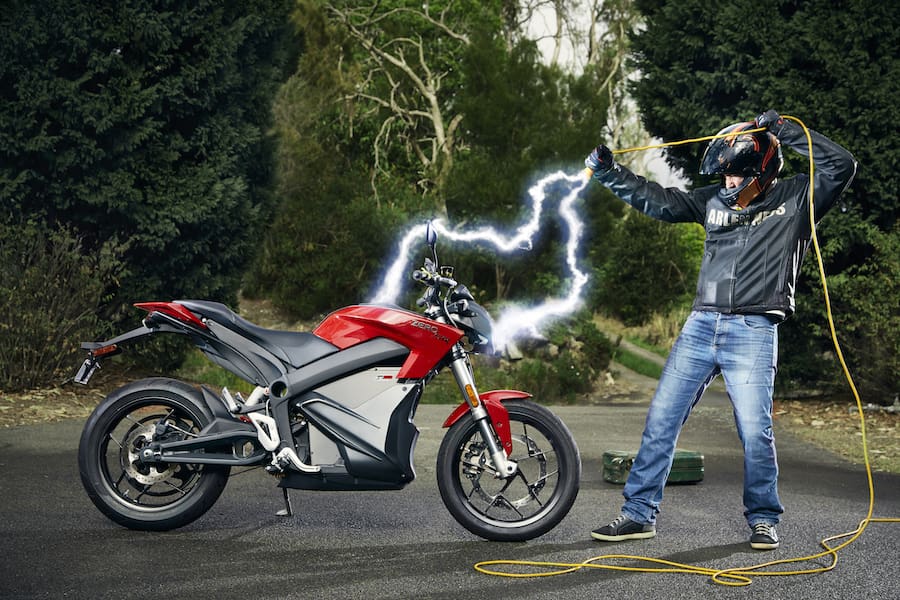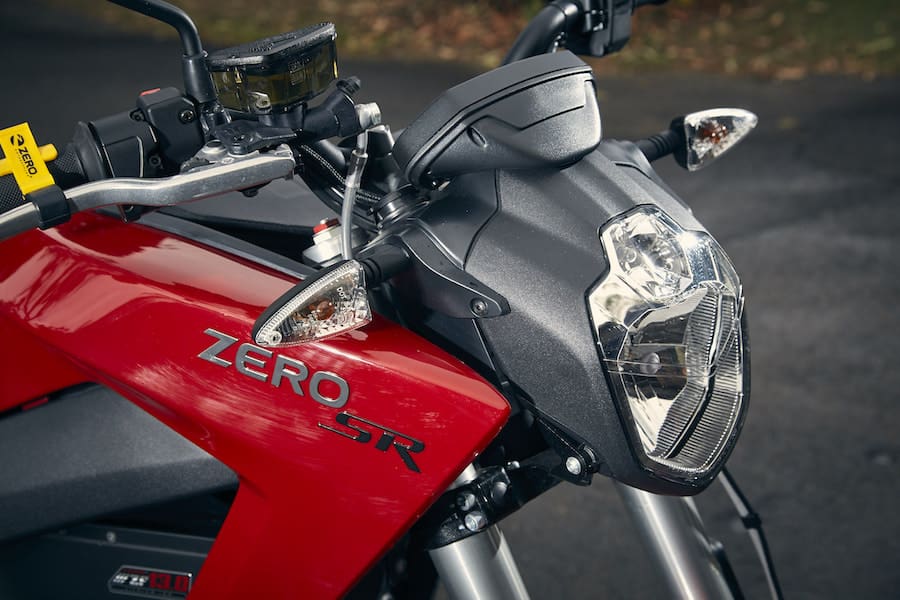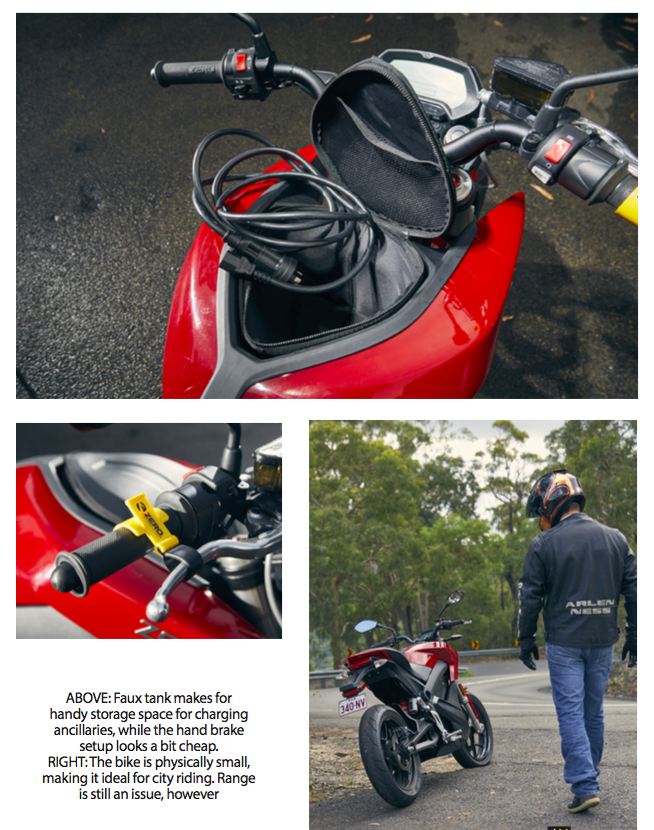Near-silent brute force is the calling card of the Zero SR 13.0 – potentially the breakout electric sportsbike
I leave home early in the morning, often. The joy of suburban life is that my neighbours line the garage side of my house, and I have woken them over the years with a variety of machinery. Flippantly piped Ducatis, deep-throated Harleys, hyperactive sportsbikes, two-strokes – I have crashed my neighbours’ dreams with them all. It does put a certain strain on the relationship.
On this morning, however, once the garage door stopped creaking, there was almost silence. I switched on the Zero SR, but rather than the bark of pistons eating fuel vapour, it’s a barely audible click a few seconds later that signifies the bike is ready to go. I glided up the driveway and out of there, the only sound a very mild electrical engine noise and of the tyres sticking to the road.
It is a very gentle way to start a motorcycle ride and while many of us are all about noise and feeling the power and something throbbing between our legs, there is the elegant side of motorcycling that this Zero’s genteel way of going about things emphasises. There’s not much genteel, however, about how it accelerates.
ZERO SR 13.0

Electric motors are famous for shit-tonnes of torque, and this bike delivers there. Zero claims 144Nm of the twisting stuff from its Z-Force motor, and as it whines its way – sounding like a heavily muted supercharger – towards 100km/h at close to the claimed 3.3secs, it does indeed leave a collective of confused car drivers in its wake. There are many reasons for this, not just the near-silent speed of it.
For a start, the bike is tiny and its looks don’t telegraph the fact the thing hammers in a straight line. The rear of the bike looks good to me, but the front is pretty uninspiring – it doesn’t look like the big-ticket item it is. It does when you get up and close to it, though.
The Zero is high-quality throughout, not a creaky, plasticky annoyance. It is well-solid, and when your eyeballs explore the most expensive item on the bike – that high-tech Lithium-ion battery – you can see where the R&D has gone. It’s a wondrous thing when you compare that battery with what has come before it.

Battery tech has always been what holds electrical vehicles back, but this triumph of technology now allows proper range (more on that later) as well as the ability to be topped up without damaging battery memory, etc. We have had that technology on those mini-computers we call ‘phones’ for years, but now it applies to large battery packs, too. And this is just the start of it – there’s a heap of development to come. Just ask Tesla.
Like every second bike these days, the Zero has a few modes to choose from, as well as the ability to connect your phone to the thing via an app and build your own mode. If you are addicted to your phone, this is another reason to stare at that small screen.
The Eco mode, like most wet/eco modes, borders on boring, but is definitely effective in earning you more kilometres from a single charge. How many exactly? I don’t know to the kilometre, because I quickly got in the habit of plugging the thing into a wall to top it up at every opportunity, much like you do with a smartphone these days.
Due to the boringness of the ‘sensible’ mode I was also often in the Sport mode, and using full throttle as frequently as I could. Doing it this way, it’s possible to burn through a charge in 100km or less, even with the brakes helping to re-generate power as they do. Zero claims 240kms from a charge is possible. I never got close to that, but if I tried to get range, and used eco mode, I am confident I could make 160km in real-world use.
If you do coast to a halt somewhere with a powerpoint (it plugs into a standard 240V slot with the supplied plug, living in a pouch at the front of the bike), you will be there for a good while before you have enough charge to get going again for a meaningful distance – a full charge takes around eight hours.
Instead, I just plugged the bike in at every destination I got to: home, friends’ places, cafés, workplaces, etc. I added a decent extension cord to the pouch sitting where a fuel tank would be with one of those old-fashioned petrol-powered bikes, and found it pretty easy to connect. If you work somewhere regularly, it would become habit.
You can top the bike up as much as you want, and that’s better than waiting the full charge period. You know exactly how much juice you have, as the bike displays battery percentage and has a range display on the small, informative, blandly styled dash. Those numbers can be brought down quickly with some angry right hand use.
I rode the bike in all sorts of environments, but it’s clearly best suited to urban areas, purely because of the range/charging limitations. There is a Z-Force Power Tank available for $4790, which hands out a further 60km of near-silent brute force, and slots into the space the current tank bag takes up.
There is also a Charge Tank due to be available just after this story goes to print ($3990 fitted), which will allow charging in half the time. It fits where the Power Tank does, so you can choose either, but not both. The catch is the Charge Tank requires a car-spec charging plug – you just can’t draw enough power out of a household powerpoint to charge that fast.
When you add that to the bike’s asking price, it might at first seem like a convenience that doesn’t come cheap. But remember, you aren’t pouring oil or petrol into it; your most expensive consumables are the excellent Pirelli tyres – and it’s not real hard on them, judging by the three weeks I had it.
It feels exactly like a regular motorcycle to ride in many areas, but it’s quite different in others. The motor comes on reasonably mildly in Sport mode, just to prevent all that torque turning your rear tyre to smoke, but by 20km/h it has a lot of grunt ready to go – it really hammers, with another kick around the 80km/h mark.
Punching it into gaps and ahead of traffic is easy. There’s no clutch to bother with, just open the taps and the clutch-less direct drive does its thing.
There is a lot of space in front of your left hand and above your left foot – the lack of clutch and gear lever takes some getting used to. For the first dozen corner entries I found myself reaching for a magical clutch lever and trying to downshift, for no reason or gain.
There is little engine braking on this bike (two-stroke riders will be stoked) so you rely on the brakes to slow down. It will reduce speed when you back off, but not drastically. The ABS-equipped brakes use the Bosch 9 system, which means smooth ABS performance and not too much intervention.
I am pleasantly surprised at how that throttle feels – it’s really similar in action and response to the average modern petrol machine. You can incrementally add power very accurately and the bike is great in tight traffic for this reason. It does have an average turning lock, for no reason I can see other than it hits the lock stops earlier than it feels it should.
Aside from that, it’s a weapon in the traffic light wars. It’s small and narrow, so lane filtering is easy, just watch for pedestrians who don’t hear you coming. Same goes for drivers. Many times I just appeared beside a car at standstill and the driver did a double take – their first sense that registers you is sight, not hearing, and it freaks them out.
At a standstill the Zero is dead silent, and it’s weird hearing people talking about you in their cars, hearing your own indicators clicking, hearing your own breathing. It’s like you are standing there in traffic, wearing a helmet. But then the light goes green and you near-silently put a large gap between you and the herd. Quietly being flung up the road on your super-smooth steed is a feeling that’s hard not to love, and one I revelled in.

When it comes to cornering, the Zero’s small, compact chassis lends it nimbleness and the whole package only weighs 188kgs (claimed, ready to ride). The wheels are narrow, which reduces rolling resistance, and also helps it get from side to side with little effort. The light weight and small dimensions means it feels similar to other bikes its size, but the lack of engine braking and that rocketship of a Z-Force motor give it a feel all its own in the corners.
The Showa suspension is good quality ride-wise, though like the rest of the bike, the fork does look plain. The Zero is balanced nicely between the wheels – an art with that big battery pack sitting in the middle – and the Showa boingers handle everything from potholes to throttle-happy riding.
The feel on offer when things get faster is different to other bikes, but while the Zero is aimed at urban use, it does carve a good line through the corners and again surprises anything else on the road. I glided past a cyclist at one point, and when he caught up with me later as I had a break roadside, he admitted I had scared the bejesus out of him. He just never knew I was there, until I physically was.
I even managed two laps of Sydney Motorsport Park, and the thrill of rolling around there in near-silence was unique, though I nearly hit a slow-to-move bird – poor thing probably thought the day was over, and the middle of turn five was the perfect place to hang out.
I couldn’t really get stuck in, however, as the bike’s feel is different, and while I ride a different bike every week, it took me a long time to get totally comfortable – the bike feels foreign in flat-out riding, and I never got absolutely happy in the time I had.
The brakes and motor handles the track fine, though I wasn’t exactly at race pace, even if I did use five per cent of battery in those two laps! A custom map, tyre warmers, a fast charger, and it would be a fun day at the track.
The Zero SR 13.0 isn’t a perfect bike, with some range limitations for those wanting to wander, a piece of plastic acting as the handbrake and a sidestand that is 75mm too short – not good enough on a bike with this price tag.
But for riders who want to do their bit for the environment – assuming they charge it with wind, surf or solar power – want something different, enjoy playing with all things electronic, like to adjust their bike with an app on their phone and just revel in fierce acceleration in near silence, the Zero SR is as good as electric bikes have ever been.
With more and better fast chargers in the pipeline and qualities that make it especially suitable as an urban bike, the Zero SR is now a viable option: That’s assuming you can get past the still-hefty price tag of course – the bike as-tested is $26,490 + ORC. Remember though, you aren’t putting petrol into it, ever, and servicing is about looking after the chassis only – no valve adjustments, oil changes, timing chains, etc. Zero claims the motor is good for over 450,000km!
The battery makes up a large heft of that price, so there is talk of leasing the things to make the bike more affordable and a whole swag of other measures to make this new form of transport manageable. The bike itself is great, it’s purely the practical elements still being worked out that will determine whether it becomes mainstream. In the meantime, the Zero SR is the best electric bikes have ever been, and has plenty of appeal as an urban warrior with a skillset other motorcycles can’t match. Tech-heads with big wallets won’t be able to resist it.

There were a few questions I got asked every time I took the Zero SR out – you can’t be shy when riding one of these as everyone wants to talk to you. Here are the answers:
- Can you ride it in the rain? Yes, you won’t get electrocuted. You can wash it, get it wet, just like any other bike.
- Is it silent? No, it’s not. On WOT, there’s a very mild electric motor whine, not much louder than a remote control car. Electric motors aren’t silent! Compared to an Akrapovic-piped Italian V-twin, though, yes, it’s relatively quiet.
- Where’s the clutch? There isn’t one – it’s like a scooter in this regard, making it really easy to ride, The main difference is that only the big maxi scooters could keep up with it in a straight line. And they make a lot more noise.
- Is it fast? Yes, it is. Straight line speed isn’t far off a fully blown sportsbike, but it is much easier to get off the line quickly, with no clutch or gears to worry about.
- Can you plug it into a powerpoint? Yep – it charges overnight in the shed, or plugged into an outside powerpoint, or into an extension cord out the window. This changes if you opt for the Charge Tank, which needs a larger car-spec charging point.

Competition
Ummm, there isn’t any when it comes to road-registered two-wheelers. There are plenty in racing series such as TTXGP and the bikes that compete in the IOM races, but while there are some great examples of fast machines in those series, no one else has the range or balls of Zero when it comes to models that can be purchased for use on the road. It’s a whole new world and they are boldly striding into it with products that work, but go against conventional thinking – you have to admire Zero for that.
Energy wars
My only problem with electric bikes is that while they don’t use fuel, at this point you predominately need to burn coal to charge them (or fire-up a petrol-powered generator), so the perceived environmental savings aren’t as great as some claim.
There was once a tongue-in-cheek ‘press release’ centring on the fact a car manufacturer had found a way to power a hybrid car on the smugness of its owners…
However, with wind, solar and surf power becoming more mainstream, and with the massive leaps in battery technology each and every year, this is becoming a moot point. These vehicles are here to stay – something that couldn’t be said five years ago.
Swap stations
There are a number of ideas being bandied about to improve range on electric vehicles. One is the use of a few standard-type batteries that can be swapped between bikes – just like you do with BBQ gas cylinders. Pull up, swap out your dead battery for a fresh ’un, and away you go! This is a long way off, obviously, but it’s an options.
TEST SAM MACLACHLAN PHOTOGRAPHY JOSH EVANS



